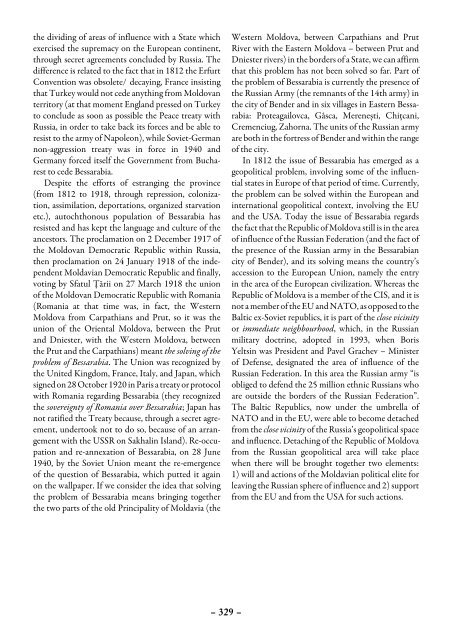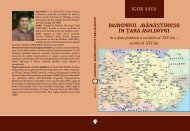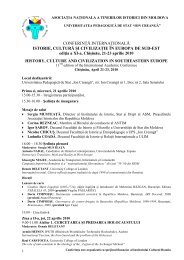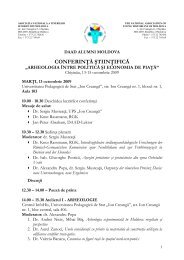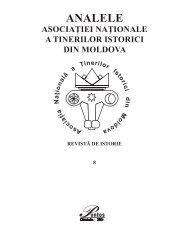aici - Asociatia Tinerilor Istorici din Moldova
aici - Asociatia Tinerilor Istorici din Moldova
aici - Asociatia Tinerilor Istorici din Moldova
Create successful ePaper yourself
Turn your PDF publications into a flip-book with our unique Google optimized e-Paper software.
the divi<strong>din</strong>g of areas of influence with a State which<br />
exercised the supremacy on the European continent,<br />
through secret agreements concluded by Russia. The<br />
difference is related to the fact that in 1812 the Erfurt<br />
Convention was obsolete/ decaying, France insisting<br />
that Turkey would not cede anything from <strong>Moldova</strong>n<br />
territory (at that moment England pressed on Turkey<br />
to conclude as soon as possible the Peace treaty with<br />
Russia, in order to take back its forces and be able to<br />
resist to the army of Napoleon), while Soviet-German<br />
non-aggression treaty was in force in 1940 and<br />
Germany forced itself the Government from Bucharest<br />
to cede Bessarabia.<br />
Despite the efforts of estranging the province<br />
(from 1812 to 1918, through repression, colonization,<br />
assimilation, deportations, organized starvation<br />
etc.), autochthonous population of Bessarabia has<br />
resisted and has kept the language and culture of the<br />
ancestors. The proclamation on 2 December 1917 of<br />
the <strong>Moldova</strong>n Democratic Republic within Russia,<br />
then proclamation on 24 January 1918 of the independent<br />
Moldavian Democratic Republic and finally,<br />
voting by Sfatul Ţării on 27 March 1918 the union<br />
of the <strong>Moldova</strong>n Democratic Republic with Romania<br />
(Romania at that time was, in fact, the Western<br />
<strong>Moldova</strong> from Carpathians and Prut, so it was the<br />
union of the Oriental <strong>Moldova</strong>, between the Prut<br />
and Dniester, with the Western <strong>Moldova</strong>, between<br />
the Prut and the Carpathians) meant the solving of the<br />
problem of Bessarabia. The Union was recognized by<br />
the United Kingdom, France, Italy, and Japan, which<br />
signed on 28 October 1920 in Paris a treaty or protocol<br />
with Romania regar<strong>din</strong>g Bessarabia (they recognized<br />
the sovereignty of Romania over Bessarabia; Japan has<br />
not ratified the Treaty because, through a secret agreement,<br />
undertook not to do so, because of an arrangement<br />
with the USSR on Sakhalin Island). Re-occupation<br />
and re-annexation of Bessarabia, on 28 June<br />
1940, by the Soviet Union meant the re-emergence<br />
of the question of Bessarabia, which putted it again<br />
on the wallpaper. If we consider the idea that solving<br />
the problem of Bessarabia means bringing together<br />
the two parts of the old Principality of Moldavia (the<br />
Western <strong>Moldova</strong>, between Carpathians and Prut<br />
River with the Eastern <strong>Moldova</strong> – between Prut and<br />
Dniester rivers) in the borders of a State, we can affirm<br />
that this problem has not been solved so far. Part of<br />
the problem of Bessarabia is currently the presence of<br />
the Russian Army (the remnants of the 14th army) in<br />
the city of Bender and in six villages in Eastern Bessarabia:<br />
Proteagailovca, Gâsca, Merenești, Chiţcani,<br />
Cremenciug, Zahorna. The units of the Russian army<br />
are both in the fortress of Bender and within the range<br />
of the city.<br />
In 1812 the issue of Bessarabia has emerged as a<br />
geopolitical problem, involving some of the influential<br />
states in Europe of that period of time. Currently,<br />
the problem can be solved within the European and<br />
international geopolitical context, involving the EU<br />
and the USA. Today the issue of Bessarabia regards<br />
the fact that the Republic of <strong>Moldova</strong> still is in the area<br />
of influence of the Russian Federation (and the fact of<br />
the presence of the Russian army in the Bessarabian<br />
city of Bender), and its solving means the country’s<br />
accession to the European Union, namely the entry<br />
in the area of the European civilization. Whereas the<br />
Republic of <strong>Moldova</strong> is a member of the CIS, and it is<br />
not a member of the EU and NATO, as opposed to the<br />
Baltic ex-Soviet republics, it is part of the close vicinity<br />
or immediate neighbourhood, which, in the Russian<br />
military doctrine, adopted in 1993, when Boris<br />
Yeltsin was President and Pavel Grachev – Minister<br />
of Defense, designated the area of influence of the<br />
Russian Federation. In this area the Russian army “is<br />
obliged to defend the 25 million ethnic Russians who<br />
are outside the borders of the Russian Federation”.<br />
The Baltic Republics, now under the umbrella of<br />
NATO and in the EU, were able to become detached<br />
from the close vicinity of the Russia’s geopolitical space<br />
and influence. Detaching of the Republic of <strong>Moldova</strong><br />
from the Russian geopolitical area will take place<br />
when there will be brought together two elements:<br />
1) will and actions of the Moldavian political elite for<br />
leaving the Russian sphere of influence and 2) support<br />
from the EU and from the USA for such actions.<br />
– 329 –


